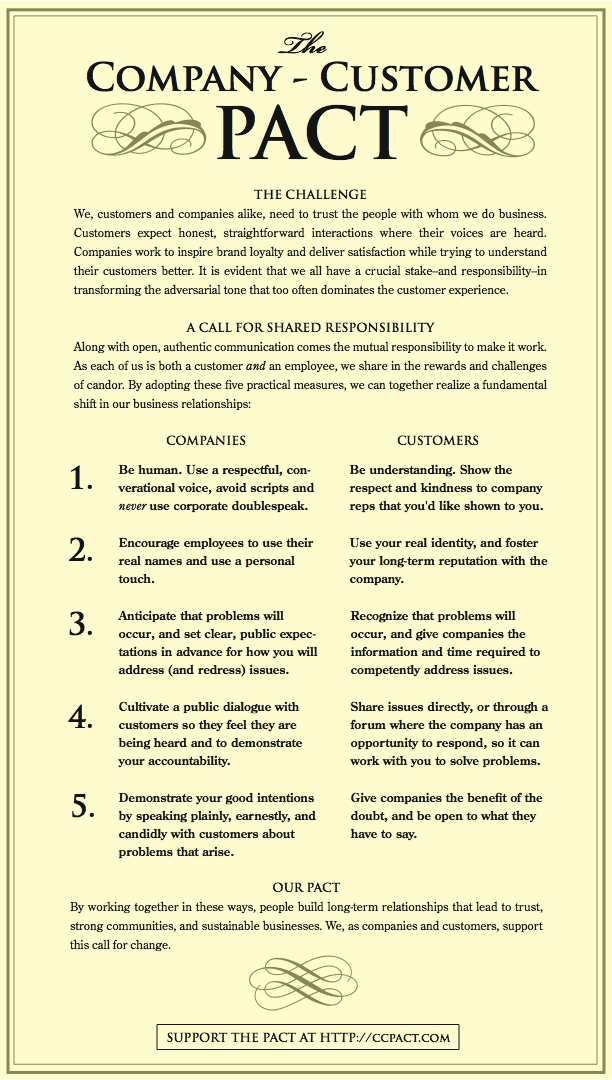I recently hosted a workshop at the Satisfaction event, Customer Service is the New Marketing. The topic I’m focused on was, “How to Listen to the Market and How to Engage Customers Online.”
Fellow workshop leaders include Christopher Carfi, Deb Schultz, Chris Heuer, Jeremiah Owyang, Becky Carroll, and Douglas Hanna.
Empowering your customers to become an extension of your marketing and sales forces isn’t new, but it isn’t widely embraced either. In fact, the function of most customer service has been relegated to overseas companies or even automated as companies seek to reduce the costs of keeping customers happy.
However, in the era of Social Media, simply having a customer service infrastructure is no longer enough. This is about people and engaging them as people, evolving from an approach that connects faceless companies to anonymous customers. Let’s humanize the entire process to not just keep customers happy, but also cultivating loyalty along the way.
Technology will always evolve and the tools will continually change.
Customer service, product marketing and marcom must fuse into a living, breathing commitment of inbound and outbound initiatives that not only answers questions when they come in, but also seek them out wherever they seek insight from peers and other experts.
It’s a combination of using Social and Traditional tools to discover, listen, learn, and engage directly with customers to help, not market, but help them make decisions and also do things that they couldn’t, or didn’t know how to do, before today.

And, most importantly, the lessons learned in the field should in turn be fed into the marketing department to create and run more intelligent, experienced, and real world initiatives across all forms of marketing, PR, sales, and advertising.
I know this all sounds wonderful, but where do you even start and who’s responsible for what?
Truth is, that it’s going to be different within each organization. It all starts with a champion and that person could be an executive, in PR, marcom, customer service, or product marketing or all of the above.
Someone needs to realize that it just can’t be an inbound process, as Social Media is not a spectator sport. Those who sit on the sidelines will inevitably fall off the radar screens of their customers, giving way for competition to satisfy their needs.
Speak up. Don’t question whose responsibility it is, just present it as an idea along with supporting data (it’s out there). It’s not only about pulling your company into the online conversations that will help customers, it’s also about empowering your customers to help each other.
Delegate the responsibility of listening as well as assigning necessary responses among the most appropriate voices within your organization as well as your champions out in the field. In many cases, businesses are hiring “community managers” to keep the company’s ear to the ground and to also act as the hub for coordinating all outbound conversations. The community manager usually works directly with PR, product marketing, customer service, and also the executive team to pull in the right people for the job and to also answer questions in case the CM needs to engage directly.

The best way to start is by setting up Google Alerts for your company, products, key personnel, and also competitors. Every time something comes up, you have an “almost” realtime opportunity to engage.
It’s also important to search and comb through services that track conversations and relevant topics such as Technorati, Blogpulse, Bloglines, b5, Google Blog Search, Blog Catalog, and also MyBlogLog. These tools allow you to proactively monitor memes and determine your level of engagement.
Social Media isn’t limited to blogs and communities. Social Media is also fueling social networks and the ability to find and host conversations related to brands and products. For example, Creating Facebook groups as well as searching other related groups are incredible opportunities to have conversations with people and as well, influence groups of people in the process.
Several companies I work with have created company-hosted groups across relevant social networks as well encouraged enthusiastic customers to do host conversations in places such as Ning. Ning is a Do It Yourself (DIY) social network, and it’s definitely a place where people congregate to share and learn, among other things of course.
Another way to help customers is to bring them to you through your own company blog as well as hosting an integrated social network/discussion forum. Companies such as Leverage Software facilitate hosted conversations directly at the company site as a way of embracing customers and also encouraging peer-to-peer interaction…thus building and strengthening their community.
Companies such as Satisfaction are creating “people-powered” customer service forums where companies and customers can create a channel dedicated to helping people use products more effectively by solving their problems and answering questions all in one place. In many cases, services such as Satisfaction are complementary to all other campaigns.
Don’t count out micromedia tools…creating a presence in Twitter and Jaiku can help companies on the spot as these conversations are taking place.
In the case of Twitter, companies can create an account where they can proactively update their customers aka “followers” with new updates, answers, etc. Customers can also contact them through “direct” messaging or public @companyname posts. #hashtags is a growing trend within the service that allows users to callout topics such as #customer+service for others to locate through a dedicated search tool.
Jaiku integrated channels last year, for example, allowing anyone, in this case, companies, to create a dedicated pipe to share and reply to users looking for specific information and conversations.
There’s still a 1.0 component to all of this however. User groups and forums haven’t gone away. They’re still thriving, and, determining which communities host conversations that matter to your business in critical in maintaining customer service and also instilling satisfaction and fostering enthusiasm.
Which communities and tools should you use? You have to start by surveying the landscapes and listening. The results will tell you where to engage. Monitoring the culture of each community and the sociology of the interactions, will guide you in how to participate.
Whatever you do, don’t’ engage as a marketer and don’t participate from a top down approach – meaning be helpful, not “put out” from having to answer the same things over and over again.
We’ve all heard that in Social Media, we can’t control the message. To some extent, we can’t control perception, but we can help steer it. Be helpful and ensure that your solutions and benefits are clear in a way that can be understood by the different demographics of users that populate your markets. And remember, they need to hear things differently across each segment, from the head, to the long tail across every chasm in between. It’s not just about the masses, but the niche markets as well. They all contribute to the bottom line.
Graphic, and insight, courtesy of Chris Heuer
The importance of engagement is to ensure that you engage on their terms according to the rules, and culture, across each community. Remember, in life, you are also customers. You buy things, you complain about products and services you don’t like, and you recommend those that you love. So, you have to be a customer to think like a customer. Approaching them any other way isn’t genuine and is going to deflate relationships and spark the possibility of pushing customers away.
Be the people you want to help.
Most importantly, make sure that you integrate customer success stories into your PR and marketing initiatives. Feature them on your blog. Invite them to events. Partner with them to be proactive voices to help rally other customers. After all, customers are the very thing that keep you in business. Show them that you know this by reaching out to them, not just waiting for them to come to you.
The Company-Customer Pact
Now, let’s take a look at a couple of examples (from a 40,000 foot view.) If you have stories you’d like to share, please send them in and I’ll be sure to include them in the ebook that I’ll publish as an extension to this post.
Experience Case Study

FreshBooks is by far, one of my favorite examples for a company that gets it. They live and breathe customer service and mandate that everyone, at every level, engage with customers to stay connected with them. In doing so, everything from sales, marketing, and also product development, stay on track with what their customers really need and want.
How FreshBooks Listens:
Comments on its blogs
Google alerts
Created a hosted forum, which is very active
They answer their phones…no automated attendant
Twitter
Customer dinners
Attending conferences where their customers go
According to Michael McDerment of Freshbooks, “Since day one of FreshBooks operation there has been a mandate to over serve FreshBooks customers. A customer service department was formed before even a marketing team. That original mandate has carried on today with all the same principles.”
Real Support and staying tapped in! Every member of the FreshBooks team, from the CEO to the Developers to the Marketing Department also doubles as the support team.
Real World Relationships! FreshBooks communicates with customers through their blog, forums, Twitter, a Newsletter called the FRESHBOOKS SUPPER CLUB, the real word version of the FreshBooks Supper Club. Basically any time someone from FB travels we take a group of customers out for a nice dinner for no reason other than to hang out and get to know them.
Make customers part of the PR process. Feature them regularly on the blog and through other promotional materials.
FreshBooks takes a “Treat people the way you want to be treated” philosophy because they feel that if the people are happy inside theirs walls, they will convey that happiness and excitement to their customers, and in turn, their customers will share that goodness with others.
FreshBooks takes customer service on the road and is renting an RV in February and driving from Miami to Texas to eat breakfast, lunch and dinner with customers. The idea of this came from the fact that they are attending two conferences (Future of Web Apps and South By South West) that are a week apart. Instead of flying, they’re driving and making key stops along the way to meet customers in their cities, host BBQs, and generally just show them that they’re important.
Results: Freshbooks went from a 98% referral rate in 2006 to an unbelievable 99% referral rate in 2007.
—–
Engagement Example: AOL

Will Morris, AOL’s man in Silicon Valley, and Frank Gruber, who works out of the east coast HQ, vowed to help engage unhappy customers across the Web as well as critics of the company’s products to help shed new light to each discussion, clarify confusion, and simply help in general.
Will recently wrote about it as a way of inspiring his co-workers to do the same, “Don’t let people say silly things about your company. Yes I mean it. Your company.” Morris continued, “Frank Gruber set an example for me last year. When he spots these comments, he follows up with a comment and (if possible) contacts the person who wrote it. And the response is normally good. If Frank can do it (as busy as he is), so can we all do it.”
Frank Gruber added to the discussion, “Will Morris has been a leader at the AOL Silicon Valley campus for over 9 years…he is making sure that employees realize that they can make a difference by taking pride in their work and by engaging directly with customers.””
Examples from Frank:
The moment TechCrunch announced myAOL, a new personalized startpage, it was met by critics that had not even looked at the product but saw it was from AOL and immediately took a negative stance. As the myAOL product lead, Gruber took this on as a challenge. He made sure to comment and contact individuals to get real feedback on the product. You can see some of the comments here.
Gruber took the time to reach out through comments and emails. In one such case, Gruber contacted open critic, Matt Harwood. Harwood took a position that was very much against myAOL when the Sneak Preview video splashed onto pages of TechCrunch in June. In August, he had changed his mind and opted to share his new sentiment publicly.
Gruber responded, “Matt’s open dialog says a lot about his character and I really appreciate it. It is feedback like his that helps improve a product.”
—-
Connect with me on Twitter, Jaiku, Pownce, Plaxo, or Facebook









I recently overheard the CEO of a global, multi billion dollar high tech manufacturing company say that he couldn’t justify a single new hire in North America if he could source the position in China or India and get the same level of production.
In a viciously competitive global market, in world driven by stock value, in an industry where LEAN is sexy, providing adequate customer service is frequently good enough, and doing more with less has become excruciatingly cliché.
FreshBooks’ story is a refreshing anomaly. A culture of people who get it from top to bottom in the context of a company still right sized to keep the momentum going.
The AOL example should prove to be more interesting as it plays out.
The fact that Morris and Gruber get it certainly means the internal champions for capitalizing on social media are well placed, but shifting a culture of that size should prove to be a challenge on many practical levels, not the least of which is the legal and MAR/COM departments’ death grip on outgoing messaging.
I’ll bet heads exploded all over both departments at AOL when they hear these guys tell everyone in the company to go out and defend the company in the blogosphere.
Fantastic post!
The corporate enterprise is waking up to two major things.
1. The future belongs to the trends that youth embrace – i.e. Social Networking, Blogging, Digital Media etc.
2. These mediums are in fact, a perfect fit to business and brand – not an enemy or change that should be feared.
In 2001, when we started selling branded social networks for businesses, many executives were thinking “What if someone says something we don’t like? We should not let our customers interact with each other!”
In 2008, we basically see only a tiny bit of that fear left, mostly we see people who realize how valuable it is to bring their customer to right to their face – and that there is no greater evangelist than your own customers!
Besides, wouldn’t you rather control the brand and conversation rather than have it made somewhere outside of your view or control? I’d think it would be scary to let your customers communicate on anything that wasn’t part of your own site and brand!
Seems like it should be self-evident, since these same executives were spending all kinds of cash on trade events and training seminars to increase adoption of their product or service, yet they felt the online mirror of all those activities seemed like it might be out of control.
Truth is, the old threaded message boards were out of control, but true Social Networks are self-governing because they reward valued insight with respect and recognition in the community.
Subtle change makes all the difference.
It’s important for companies to take note of such tips and copy other companies that have successfully pulled customer service off. Companies should also learn how to incorporate them in their own way, as it suits the kind of service they offer. The Internet, for one, is a very good way of trying to reach out to customers and solving issues quickly.